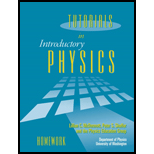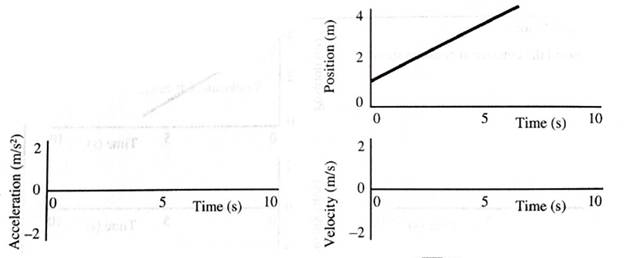
Tutorials In Introductory Physics: Homework
1st Edition
ISBN: 9780130662453
Author: Lillian C. McDermott, Peter S. Shaffer
Publisher: PEARSON
expand_more
expand_more
format_list_bulleted
Concept explainers
Textbook Question
Chapter 1.2, Problem 1dT
Description of Motion:

Expert Solution & Answer
Want to see the full answer?
Check out a sample textbook solution
Students have asked these similar questions
The cylindrical beam of a 12.7-mW laser is 0.920 cm in diameter. What is the rms value of the electric field?
V/m
Consider a rubber rod that has been rubbed with fur to give the rod a net negative charge, and a glass rod that has been rubbed with silk to give it a net positive charge. After being charged by contact by the fur and silk...?
a. Both rods have less mass
b. the rubber rod has more mass and the glass rod has less mass
c. both rods have more mass
d. the masses of both rods are unchanged
e. the rubber rod has less mass and the glass rod has mroe mass
8) 9)
Chapter 1 Solutions
Tutorials In Introductory Physics: Homework
Ch. 1.1 - Each person in your group should obtain a ruler...Ch. 1.1 - Each person in your group should obtain a ruler...Ch. 1.1 - Each person in your group should obtain a ruler...Ch. 1.1 - Each person in your group should obtain a ruler...Ch. 1.1 - Each person in your group should obtain a ruler...Ch. 1.1 - Each person in your group should obtain a ruler...Ch. 1.1 - Each person in your group should obtain a ruler...Ch. 1.1 - A. In the space below, sketch a possible ticker...Ch. 1.1 - B. Together with your classmates, take your ticker...Ch. 1.1 - C. Based on your observations of your tape segment...
Ch. 1.1 - D. Review your earlier interpretation of the speed...Ch. 1.1 - E. Suppose you selected two widely separated dots...Ch. 1.2 - The computer program assumes a particular...Ch. 1.2 - Description of Motion:Ch. 1.2 - Description of Motion:Ch. 1.2 - Description of Motion:Ch. 1.2 - How are the motions in parts C and D similar? How...Ch. 1.2 - Description of Motion:Ch. 1.2 - Description of Motion:Ch. 1.2 - Description of Motion: Move toward the detector...Ch. 1.2 - How do the acceleration graphs for F, G, and H...Ch. 1.2 - Description of Motion: Initially move away from...Ch. 1.2 - Description of Motion:Ch. 1.2 - Description of Motion:Ch. 1.2 - The term decelerate is often used to indicate that...Ch. 1.3 - Draw vectors on your diagram that represent the...Ch. 1.3 - B. In the space at right, compare the velocities...Ch. 1.3 - Consider the change in velocity vector between two...Ch. 1.3 - Use the definition of acceleration to draw a...Ch. 1.3 - Does the acceleration change as the ball rolls up...Ch. 1.3 - Generalize your results thus far to answer the...Ch. 1.3 - Choose two successive points. In the space at...Ch. 1.3 - In the space at right, draw a vector to represent...Ch. 1.3 - Choose a point before the turnaround and another...Ch. 1.3 - Suppose that you had chosen the turnaround as one...Ch. 1.3 - In the space at right, draw a vector that...Ch. 1.4 - Prob. 1aTCh. 1.4 - If you were to choose a different origin for the...Ch. 1.4 - On a separate part of your paper, copy the...Ch. 1.4 - Suppose you were to choose a new point on the...Ch. 1.4 - On a separate part of your paper, copy the...Ch. 1.4 - Suppose the object started from rest at point E...Ch. 1.4 - At several points on each of the diagrams below,...Ch. 1.5 - The second diagram at right shows the positions of...Ch. 1.5 - The picture of the spaceships and shuttle from the...Ch. 1.5 - Prob. 1cTCh. 1.5 - Spaceship C moves so as to remain a fixed distance...Ch. 1.5 - Consider the following statement: "The...Ch. 1.5 - Prob. 1fTCh. 1.5 - Describe the motion of the car and the truck...Ch. 1.5 - Complete the diagram at right by drawing the car...Ch. 1.5 - Use your completed diagram to sketch average...Ch. 1.5 - During a small time interval t from just before to...
Additional Science Textbook Solutions
Find more solutions based on key concepts
4. What five specific threats to biodiversity are described in this chapter? Provide an example of each.
Biology: Life on Earth (11th Edition)
With what geologic feature are the earthquakes in the mid-Atlantic associated?
Applications and Investigations in Earth Science (9th Edition)
1. Which is a function of the skeletal system? (a) support, (b) hematopoietic site, (c) storage, (d) providing ...
Anatomy & Physiology (6th Edition)
Choose the best answer to each of the following. Explain your reasoning. If there is going be a total lunar ecl...
Cosmic Perspective Fundamentals
Explain how the behavior of homologous chromosomes in meiosis parallels Mendels law of segregation for autosoma...
Genetic Analysis: An Integrated Approach (3rd Edition)
Explain why it is too narrow to define the biodiversity crisis as simply a loss of species.
Campbell Biology (11th Edition)
Knowledge Booster
Learn more about
Need a deep-dive on the concept behind this application? Look no further. Learn more about this topic, physics and related others by exploring similar questions and additional content below.Similar questions
- Lab 8 Part 3 PHET Wave Interface simulation. I am having trouble with this part of the lab.arrow_forwardMick and Rick are twins born on Earth in the year 2175. Rick grows up to be an Earth-bound robotics technician while Mick becomes an intergalactic astronaut. Mick leaves the Earth on his first space mission in the year 2200 and travels, according to his clock, for 10 years at a speed of 0.75c. Unfortunately, at this point in his journey, the structure of his ship undergoes mechanical breakdown and the ship explodes. How old is Rick when his brother dies?arrow_forwardHi, I have canceled, why did you charge me again?arrow_forward
arrow_back_ios
SEE MORE QUESTIONS
arrow_forward_ios
Recommended textbooks for you
 College PhysicsPhysicsISBN:9781938168000Author:Paul Peter Urone, Roger HinrichsPublisher:OpenStax College
College PhysicsPhysicsISBN:9781938168000Author:Paul Peter Urone, Roger HinrichsPublisher:OpenStax College An Introduction to Physical SciencePhysicsISBN:9781305079137Author:James Shipman, Jerry D. Wilson, Charles A. Higgins, Omar TorresPublisher:Cengage Learning
An Introduction to Physical SciencePhysicsISBN:9781305079137Author:James Shipman, Jerry D. Wilson, Charles A. Higgins, Omar TorresPublisher:Cengage Learning Glencoe Physics: Principles and Problems, Student...PhysicsISBN:9780078807213Author:Paul W. ZitzewitzPublisher:Glencoe/McGraw-Hill
Glencoe Physics: Principles and Problems, Student...PhysicsISBN:9780078807213Author:Paul W. ZitzewitzPublisher:Glencoe/McGraw-Hill University Physics Volume 1PhysicsISBN:9781938168277Author:William Moebs, Samuel J. Ling, Jeff SannyPublisher:OpenStax - Rice University
University Physics Volume 1PhysicsISBN:9781938168277Author:William Moebs, Samuel J. Ling, Jeff SannyPublisher:OpenStax - Rice University College PhysicsPhysicsISBN:9781285737027Author:Raymond A. Serway, Chris VuillePublisher:Cengage Learning
College PhysicsPhysicsISBN:9781285737027Author:Raymond A. Serway, Chris VuillePublisher:Cengage Learning Principles of Physics: A Calculus-Based TextPhysicsISBN:9781133104261Author:Raymond A. Serway, John W. JewettPublisher:Cengage Learning
Principles of Physics: A Calculus-Based TextPhysicsISBN:9781133104261Author:Raymond A. Serway, John W. JewettPublisher:Cengage Learning

College Physics
Physics
ISBN:9781938168000
Author:Paul Peter Urone, Roger Hinrichs
Publisher:OpenStax College

An Introduction to Physical Science
Physics
ISBN:9781305079137
Author:James Shipman, Jerry D. Wilson, Charles A. Higgins, Omar Torres
Publisher:Cengage Learning

Glencoe Physics: Principles and Problems, Student...
Physics
ISBN:9780078807213
Author:Paul W. Zitzewitz
Publisher:Glencoe/McGraw-Hill

University Physics Volume 1
Physics
ISBN:9781938168277
Author:William Moebs, Samuel J. Ling, Jeff Sanny
Publisher:OpenStax - Rice University

College Physics
Physics
ISBN:9781285737027
Author:Raymond A. Serway, Chris Vuille
Publisher:Cengage Learning

Principles of Physics: A Calculus-Based Text
Physics
ISBN:9781133104261
Author:Raymond A. Serway, John W. Jewett
Publisher:Cengage Learning
Position/Velocity/Acceleration Part 1: Definitions; Author: Professor Dave explains;https://www.youtube.com/watch?v=4dCrkp8qgLU;License: Standard YouTube License, CC-BY